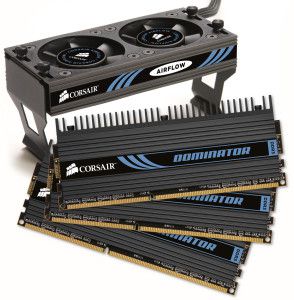From our front-page news:
Yesterday, I posted about OCZ becoming the first memory vendor out the door with a tri-channel kit for Intel's upcoming X58 platform, and it didn't take too long for another to follow. Corsair today announces three new kits also, with two variants each (3GB & 6GB). One thing the Corsair release includes that the OCZ one lacked though, is pricing information.
The lowest kit that Corsair will offer is DDR3-1333MHz (CL9), and will retail for $120 (3GB) and $230 (6GB). Moving up we have what will likely become the most popular kit among enthusiasts, the DDR3-1600 (CL8) will retail for $175 (3GB) and $300 (6GB). Lastly, Corsair wants to make sure they're among the few to offer insanely fast kits, and the DDR3-1866 (CL9) kit deserves that title. At $250 (3GB) and $475 (6GB), it's not going to be for everyone.
Among the new kits, the top two include revised Dominator heatspreaders, while the top-end kit includes a revised flow fan, which appears slightly wider and replaces three small fans with two larger ones. This is to increase airflow while reducing noise... two good things. Corsair's DDR3-1333 part is available now (which means it should creep up in e-tailers soon), while the others will likely follow in the coming weeks.

Each memory speed will feature kits of three 1 Gigabyte or 2 Gigabyte modules for a total of 3 Gigabyte or 6 Gigabyte kits. The 1600MHz and 1866MHz DDR3 memory kits will also feature the industry’s highest performance memory technology, Corsair’s patented Dual-Path Heat Exchange (DHX), for maximum performance and reliability. With six total products available, Corsair is launching the most comprehensive product line available for the Intel Core i7 processor.
The lowest kit that Corsair will offer is DDR3-1333MHz (CL9), and will retail for $120 (3GB) and $230 (6GB). Moving up we have what will likely become the most popular kit among enthusiasts, the DDR3-1600 (CL8) will retail for $175 (3GB) and $300 (6GB). Lastly, Corsair wants to make sure they're among the few to offer insanely fast kits, and the DDR3-1866 (CL9) kit deserves that title. At $250 (3GB) and $475 (6GB), it's not going to be for everyone.
Among the new kits, the top two include revised Dominator heatspreaders, while the top-end kit includes a revised flow fan, which appears slightly wider and replaces three small fans with two larger ones. This is to increase airflow while reducing noise... two good things. Corsair's DDR3-1333 part is available now (which means it should creep up in e-tailers soon), while the others will likely follow in the coming weeks.

Each memory speed will feature kits of three 1 Gigabyte or 2 Gigabyte modules for a total of 3 Gigabyte or 6 Gigabyte kits. The 1600MHz and 1866MHz DDR3 memory kits will also feature the industry’s highest performance memory technology, Corsair’s patented Dual-Path Heat Exchange (DHX), for maximum performance and reliability. With six total products available, Corsair is launching the most comprehensive product line available for the Intel Core i7 processor.
